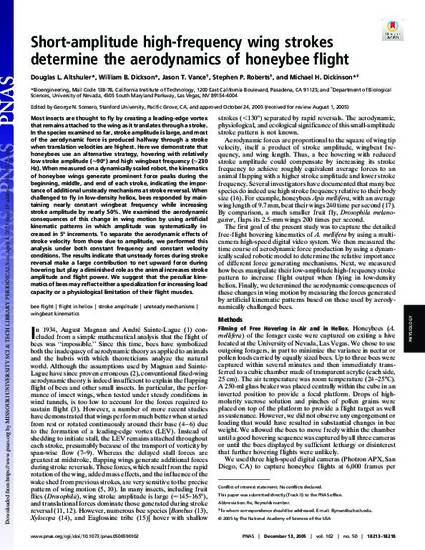
Most Insects Are Thought to Fly by Creating a Leading-Edge Vortex that Remains Attached to the Wing as It Translates through a Stroke. in the Species Examined So Far, Stroke Amplitude is Large, and Most of the Aerodynamic Force is Produced Halfway through a Stroke When Translation Velocities Are Highest. Here We Demonstrate that Honeybees Use an Alternative Strategy, Hovering with Relatively Low Stroke Amplitude (≈90°) and High Wingbeat Frequency (≈230 Hz). When Measured on a Dynamically Scaled Robot, the Kinematics of Honeybee Wings Generate Prominent Force Peaks during the Beginning, Middle, and End of Each Stroke, Indicating the Importance of Additional Unsteady Mechanisms at Stroke Reversal. When Challenged to Fly in Low-Density Heliox, Bees Responded by Maintaining Nearly Constant Wingbeat Frequency While Increasing Stroke Amplitude by Nearly 50%. We Examined the Aerodynamic Consequences of This Change in Wing Motion by using Artificial Kinematic Patterns in Which Amplitude Was Systematically Increased in 5° Increments. to Separate the Aerodynamic Effects of Stroke Velocity from Those Due to Amplitude, We Performed This Analysis under Both Constant Frequency and Constant Velocity Conditions. the Results Indicate that Unsteady Forces during Stroke Reversal Make a Large Contribution to Net Upward Force during Hovering But Play a Diminished Role as the Animal Increases Stroke Amplitude and Flight Power. We Suggest that the Peculiar Kinematics of Bees May Reflect Either a Specialization for Increasing Load Capacity or a Physiological Limitation of their Flight Muscles. © 2005 by the National Academy of Sciences of the USA.
- Bee flight,
- Flight in heliox,
- Stroke amplitude,
- Unsteady mechanisms,
- Wingbeat kinematics
Available at: http://works.bepress.com/stephen-roberts/42/

National Institute of Neurological Disorders and Stroke, Grant F32NS046221